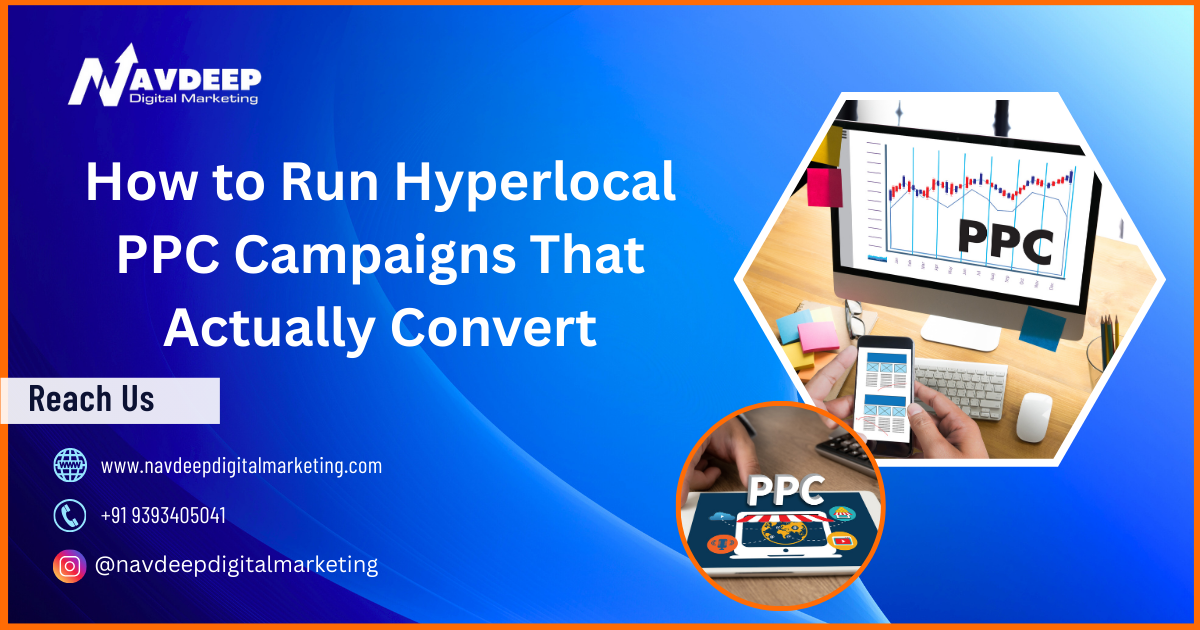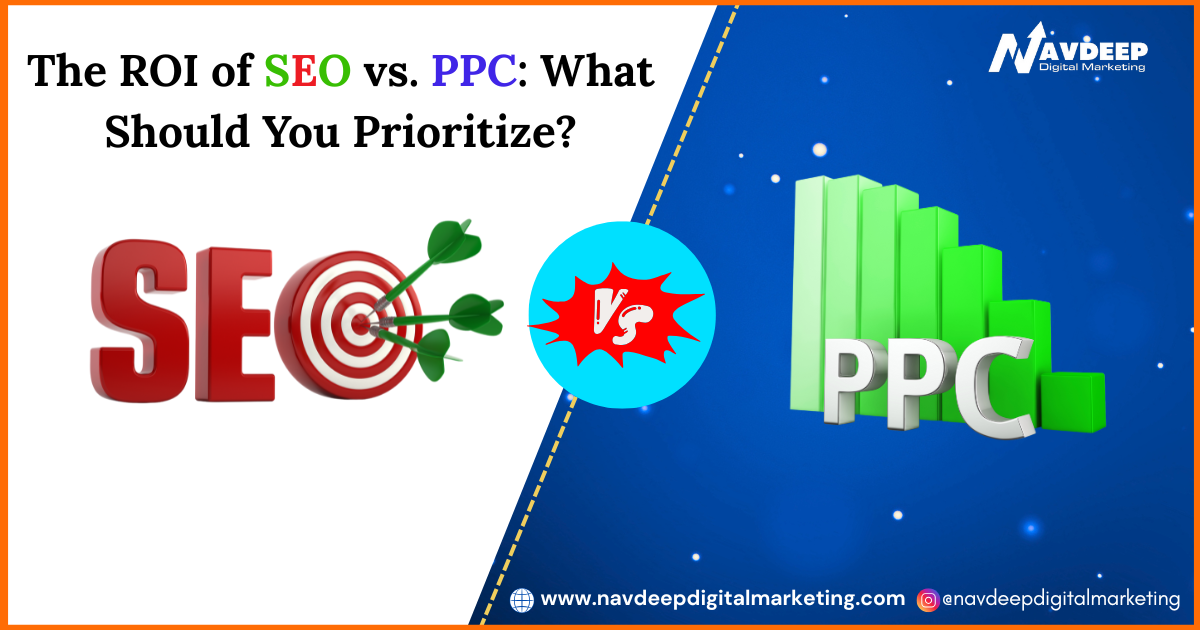How to Track and Improve Your PPC Campaign Performance
March 24, 2025 | by Navdeep Digital Marketing

Introduction
In this guide, we’ll explore How to Track and Improve Your PPC Campaign Performance, ensuring you maximize your advertising budget and improve conversions. If you’re looking for expert PPC Services in Secunderabad, Navdeep Digital Marketing offers data-driven solutions tailored to your needs. Additionally, our Instagram Advertising Services in Secunderabad can help businesses expand their reach and engagement on social media.
Running a pay-per-click (PPC) campaign is an effective way to drive traffic and generate leads, but simply setting up ads isn’t enough. Studies show that businesses earn an average of $2 for every $1 spent on Google Ads, demonstrating the power of a well-optimized PPC campaign. However, without proper tracking and continuous optimization, businesses risk wasting their ad budget with minimal returns. To achieve the best results, you must monitor performance and implement improvements consistently.
Key Metrics to Track and Improve Your PPC Campaign Performance
1. Click-Through Rate (CTR)
CTR measures how often users click on your ad after viewing it. The average CTR varies by industry, typically ranging from 3-5% for search ads and 0.5-1% for display ads. A high CTR indicates your ad is relevant and engaging, while a low CTR suggests the need for better targeting or improved ad copy. Regular A/B testing of headlines, descriptions, and display URLs can help increase CTR.
2. Quality Score
Google assigns a Quality Score based on the relevance of your keywords, ad copy, and landing page experience. A higher Quality Score can lower your cost per click (CPC) and improve your ad ranking. Optimizing your landing pages, improving ad relevance, and increasing engagement can significantly enhance your Quality Score.
3. Conversion Rate
Conversion rate measures the percentage of users who complete a desired action, such as making a purchase, filling out a form, or signing up for a newsletter. A high conversion rate indicates that your landing page and ad messaging are aligned. To improve conversions, focus on refining CTAs, enhancing user experience, and providing social proof.
4. Cost Per Conversion (CPC)
This metric represents how much you spend to acquire a customer. Reducing CPC while maintaining conversions is essential for maximizing ad spend efficiency. Utilize remarketing strategies and refine ad targeting to attract the most relevant audience at the lowest cost.
5. Return on Ad Spend (ROAS)
ROAS calculates the revenue generated for every dollar spent on PPC ads. A high ROAS signifies a profitable campaign, while a low ROAS suggests the need for optimization. Tracking ROAS across platforms like Google Ads, Instagram, and Facebook helps identify the most effective channels for your business.
Best Strategies to Track and Improve Your PPC Campaign Performance
1. Optimize Your Ad Copy
Ensure your ad copy is compelling, clear, and action-oriented. Highlight unique selling points, include strong CTAs, and naturally integrate keywords. Testing different messaging approaches, such as urgency-based copy or storytelling techniques, can help identify what resonates best with your audience.
2. Refine Audience Targeting
Use demographic, geographic, and behavioral data to reach the right audience. Platforms like Google Ads and Instagram allow for highly specific audience segmentation. By continuously analyzing user behavior, you can refine targeting strategies to enhance ad performance.
3. Utilize A/B Testing
Test variations of ad copy, images, and landing pages to determine what works best. Regularly analyzing A/B test results helps improve performance over time. Experimenting with different ad placements, bid strategies, and landing page formats can yield better results.
4. Leverage Negative Keywords
Negative keywords prevent your ads from appearing in irrelevant searches, improving CTR and saving money. For example, an online shoe store could add ‘free’ as a negative keyword to avoid appearing in searches for ‘free shoes,’ which is unlikely to convert. Regularly updating your negative keyword list helps prevent wasted ad spend.
5. Optimize Landing Pages
Ensure that your landing pages align with your ads. They should be visually appealing, load quickly, and have clear CTAs to drive conversions. Implementing heatmaps and session recordings can help analyze user behavior and improve landing page effectiveness.
6. Monitor and Adjust Bidding Strategies
Experiment with manual and automated bidding to find the most cost-effective approach. Manual bidding provides more control, allowing you to focus on high-value keywords. Automated bidding adjusts bids in real-time based on performance data, making it a great choice for scaling campaigns. A hybrid approach—starting with manual bidding and transitioning to automated—can sometimes yield the best results.
Conclusion
Tracking and optimizing your PPC campaigns is crucial for achieving long-term success. By monitoring key performance metrics and making data-driven improvements, you can enhance efficiency and maximize ROI. If you need expert PPC Services in Secunderabad, Navdeep Digital Marketing is here to help. Our Instagram Advertising Services in Secunderabad can also improve your brand’s visibility and engagement on social media.
Ready to Optimize Your PPC Strategy?
Contact Navdeep Digital Marketing today and let us help you achieve higher ROI with expert PPC management!
Frequently Asked Questions (FAQs)
1. What is PPC advertising?
PPC (pay-per-click) advertising is a model where advertisers pay a fee each time their ad is clicked, driving targeted traffic to their websites.
2. How can I improve my PPC Quality Score?
Improve ad relevance, optimize landing pages, and enhance user experience to boost your Quality Score.
3. How do I lower my cost per conversion?
Refine targeting, use negative keywords, and optimize landing pages to reduce CPC while maintaining conversions.
4. What is a good CTR for PPC ads?
A good CTR varies by industry, but a rate above 3% is generally considered strong for Google Ads.
5. Why is audience segmentation important in PPC?
Segmenting your audience helps you deliver more relevant ads, increasing engagement and conversions.
6. How does A/B testing help in PPC?
A/B testing allows you to compare different ad elements to determine which versions perform best, leading to better ROI.
7. What are negative keywords in PPC?
Negative keywords prevent ads from appearing in irrelevant searches, ensuring your budget is spent on high-intent users.
8. How can Instagram ads improve my business reach?
Instagram ads increase brand visibility, engagement, and conversions by targeting users based on their interests and behaviors.
9. How often should I review my PPC campaign performance?
Regular monitoring, ideally weekly or bi-weekly, helps you make timely adjustments and optimize ad spend.
10. Why should I hire a professional PPC agency?
A professional agency like Navdeep Digital Marketing ensures expert campaign management, maximizing ROI and minimizing wasted ad spend. For example, one of our clients in the e-commerce sector saw a 40% increase in conversions and a 25% reduction in cost per acquisition within three months of optimizing their PPC strategy with us.
RELATED POSTS
View all



